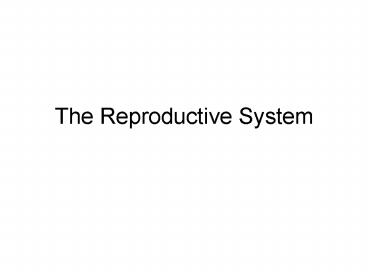The Reproductive System PowerPoint PPT Presentation
1 / 34
Title: The Reproductive System
1
The Reproductive System
2
Female Reproductive System
- Ovaries
- Duct System
- Uterine tubes (fallopian tubes)
- Uterus
- Vagina
- External genitalia
3
Female Reproductive System
4
Ovaries
- Composed of ovarian follicles (sac-like
structures) - Each follicle consists of
- Oocyte (immature egg)
- Follicular cellssurround the oocyte
5
Ovaries
Figure 16.7
6
Ovarian Follicle Stages
- Primary folliclecontains an immature oocyte
- Graafian (vesicular) folliclegrowing follicle
with a maturing oocyte - Ovulationwhen the egg is mature, the follicle
ruptures occurs about every 28 days - The ruptured follicle is transformed into a
corpus luteum
7
Support for Ovaries
- Suspensory ligamentssecure ovary to lateral
walls of the pelvis - Ovarian ligamentsattach to uterus
- Broad ligamenta fold of the peritoneum, encloses
suspensory ligament
8
Female Reproductive System
Figure 16.8b
9
Duct System
- Uterine tubes (fallopian tubes)
- Uterus
- Vagina
10
Uterine (Fallopian) Tubes
- Receive the ovulated oocyte
- Provide a site for fertilization
- Attach to the uterus
- Little or no contact between ovaries and uterine
tubes - Supported and enclosed by the broad ligament
11
Uterine Tube Anatomy and Physiology
- Fimbriae
- Finger-like projections at the distal end of the
uterine tube - Receive the oocyte from the ovary
- Cilia
- Located inside the uterine tube
- Slowly move the oocyte towards the uterus (takes
34 days) - Fertilization occurs inside the uterine tube
since oocyte lives about 24 hours
12
Female Reproductive System
Figure 16.8b
13
Uterus
- Located between the urinary bladder and rectum
- Hollow organ
- Functions of the uterus
- Receives a fertilized egg
- Retains the fertilized egg
- Nourishes the fertilized egg
14
Support for the Uterus
- Broad ligamentattached to the pelvis
- Round ligamentanchored anteriorly
- Uterosacral ligamentsanchored posteriorly
15
Female Reproductive System
Figure 16.8b
16
Regions of the Uterus
- Bodymain portion
- Fundussuperior rounded region above where
uterine tube enters - Cervixnarrow outlet that protrudes into the
vagina
17
Walls of the Uterus
- Endometrium
- Inner layer
- Allows for implantation of a fertilized egg
- Sloughs off if no pregnancy occurs (menses)
- Myometriummiddle layer of smooth muscle
- Perimetrium (visceral peritoneum)outermost
serous layer of the uterus
18
Female Reproductive System
Figure 16.8b
19
Vagina
- Extends from cervix to exterior of body
- Located between bladder and rectum
- Serves as the birth canal
- Receives the penis during sexual intercourse
- Hymenpartially closes the vagina until it is
ruptured
20
Female Reproductive System
Figure 16.8b
21
External Genitalia (Vulva)
- Mons pubis
- Labia
- Clitoris
- Urethral orifice
- Vaginal orifice
- Greater vestibular glands
22
Mons Pubis
- Fatty area overlying the pubic symphysis
- Covered with pubic hair after puberty
23
Labia
- Labiaskin folds
- Labia majorahair-covered skin folds
- Labia minoradelicate, hair-free folds of skin
24
Vestibule and Greater Vestibular Glands
- Vestibule
- Enclosed by labia majora
- Contains external openings of the urethra, vagina
- Greater vestibular glands
- One is found on each side of the vagina
- Secretes lubricant during intercourse
25
Clitoris
- Contains erectile tissue
- Corresponds to the male penis
- The clitoris is similar to the penis in that it
is - Hooded by a prepuce
- Composed of sensitive erectile tissue
- Becomes swollen with blood during sexual
excitement
26
Perineum
- Diamond-shaped region between the anterior ends
of the labial folds, anus posteriorly, and
ischial tuberosities laterally
27
Oogenesis and the Ovarian Cycle
- The total supply of eggs are present at birth
- Ability to release eggs begins at puberty
- Reproductive ability ends at menopause
- Oocytes are matured in developing ovarian
follicles
28
Oogenesis and the Ovarian Cycle
- Oogoniafemale stem cells found in a developing
fetus - Oogonia undergo mitosis to produce primary
oocytes - Primary oocytes are surrounded by cells that form
primary follicles in the ovary - Oogonia no longer exist by the time of birth
29
Oogenesis and the Ovarian Cycle
- Primary oocytes are inactive until puberty
- Follicle stimulating hormone (FSH) causes some
primary follicles to mature each month - Cyclic monthly changes constitute the ovarian
cycle
30
Oogenesis and the Ovarian Cycle
- Meiosis starts inside maturing follicle
- Produces a secondary oocyte and the first polar
body - Follicle development to the stage of a vesicular
follicle takes about 14 days - Ovulation of a secondary oocyte occurs with the
release of luteinizing hormone (LH) - Secondary oocyte is released and surrounded by a
corona radiata
31
Ovulation
Figure 16.11
32
Oogenesis and the Ovarian Cycle
- Meiosis is completed after ovulation only if
sperm penetrates - Ovum is produced
- Two additional polar bodies are produced
- Once ovum is formed, the 23 chromosomes can be
combined with those of the sperm to form the
fertilized egg (zygote) - If the secondary oocyte is not penetrated by a
sperm, it dies and does not complete meiosis to
form an ovum
33
Male and Female Differences
- Meiosis
- Malesproduces four functional sperm
- Femalesproduces one functional ovum and three
polar bodies - Sex cell size and structure
- Sperm are tiny, motile, and equipped with
nutrients in seminal fluid - Egg is large, non-motile, and has nutrient
reserves to nourish the embryo until implantation
34
Oogenesis
Figure 16.10

